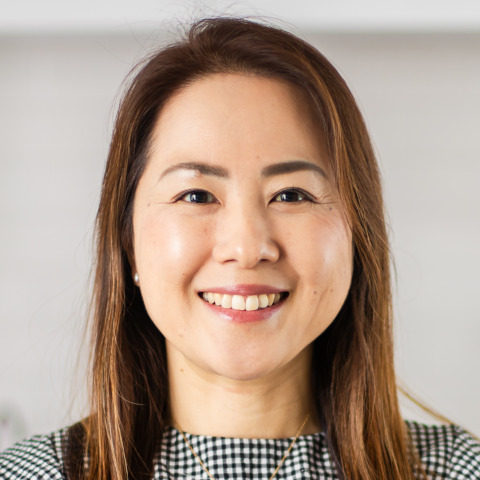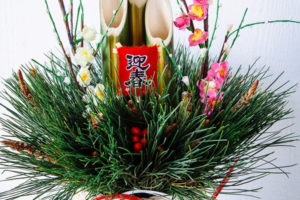How do the Japanese celebrate the Japanese New Year? Learn more about the foods, traditions, and various customs observed during this festive holiday.
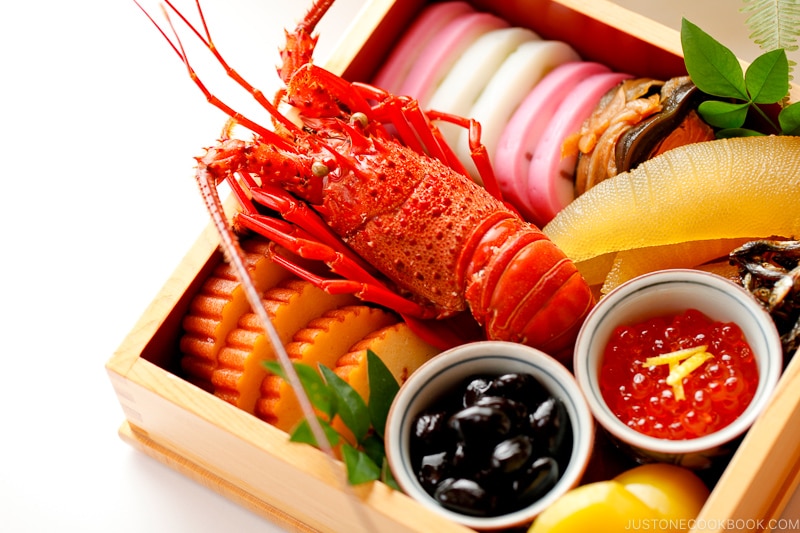
Japanese New Year (Shogatsu or Oshogatsu お正月) is the most important holiday in Japan. Since 1873, during the Meiji era, the official New Year has been celebrated on January 1st due to Western influence, rather than the New Year based on the lunar calendar (also known as Lunar New Year). This annual festival comes with many traditions and customs, each imbued with special meaning.
To usher in new beginnings, I am excited to share how the Japanese bid farewell to the old year and welcome the new year as well as foods, customs, and traditions associated with the most important holiday.
December (Shiwasu)
The month of December is called Shiwasu (師走) in Japanese, and the kanji (the written word) literally means “masters/teachers run.” It implies that December is so busy that even self-composed masters/teachers are on the run.
At the end of the year, people send out gifts called Oseibo (お歳暮) to their managers, customers, and teachers to express appreciation for the entire year. Popular gift items include fresh food (seafood, meat, and fruits), condiments, beer, tea/coffee, canned foods, desserts, and gift certificates.
Before companies shut down from the last week of the year to the first week of the New Year, there are many year-end parties with colleagues and bosses called Bonenkai (忘年会), which means “forget-the-year party.”
December 13th to 28th
From the 13th to the 28th of December, people meticulously clean their homes, offices, and businesses from top to bottom. This annual tradition is called Oosouji (大掃除), “the big cleaning.” We believe it’s important to eliminate the dust, dirt, and clutter from the passing year and to welcome the Japanese New Year with a clean and fresh emotional state.
After the house is cleaned and before the 29th of December (Number 9 is pronounced ku, with the same pronunciation as agony or torture), New Year’s decorations like kado matsu (門松) are set up on both sides of the front entrance. They are made of pine and three bamboo stalks, cut diagonally in varying lengths. Pine boughs symbolize longevity, while bamboo stalks symbolize prosperity. Now you might recognize this 🎍 emoji!
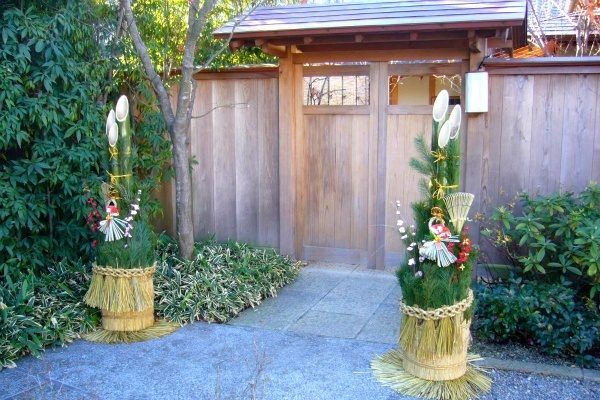
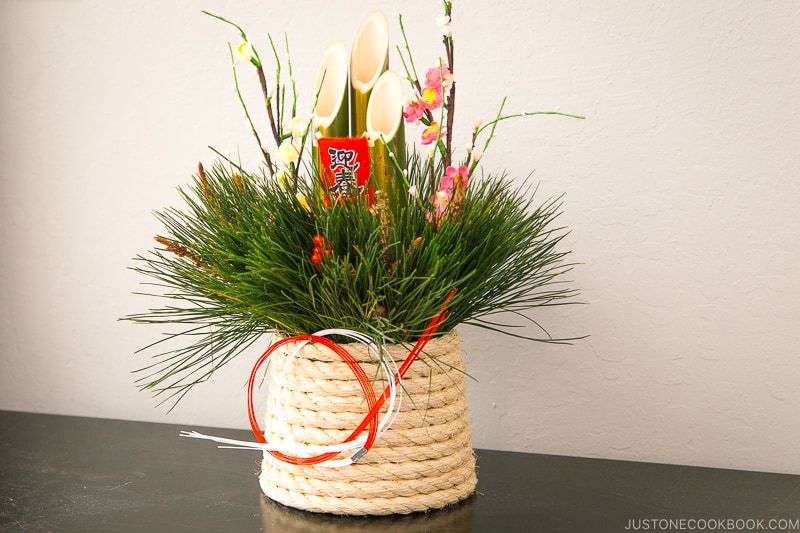
My local Japanese grocery store sells mini kadomatsu decorations like the one shown above, but there are way more decoration choices in Japan.
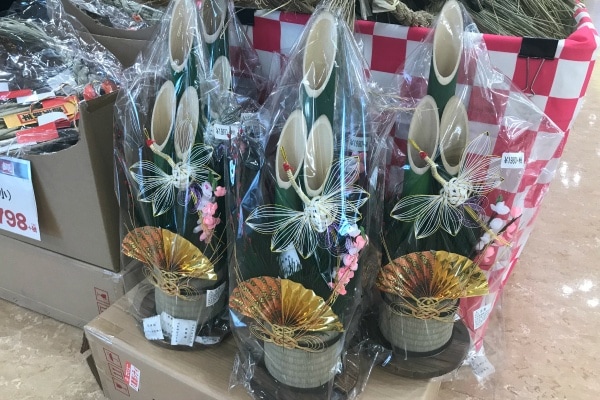
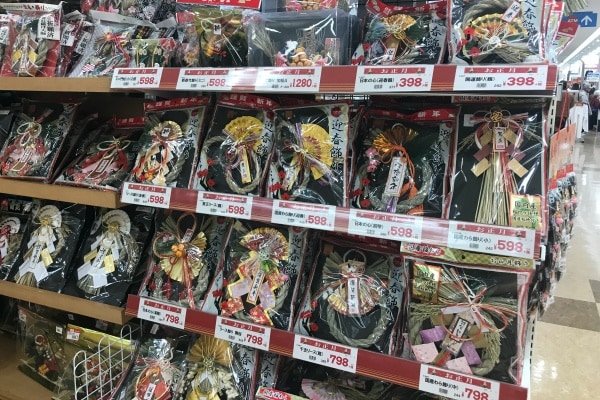
December 28th
Mochi Tsuki (餅つき), or pounding glutinous rice to make mochi, is an important traditional event in preparation for Japanese New Year and it is usually performed on the 28th, which is considered an auspicious day.
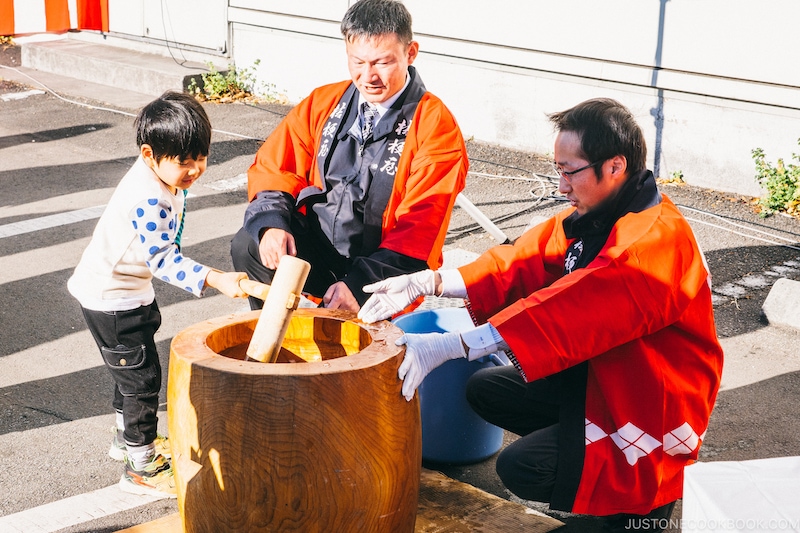
On the 28th, another traditional decoration, kagami mochi (鏡餅), is set up inside a home.
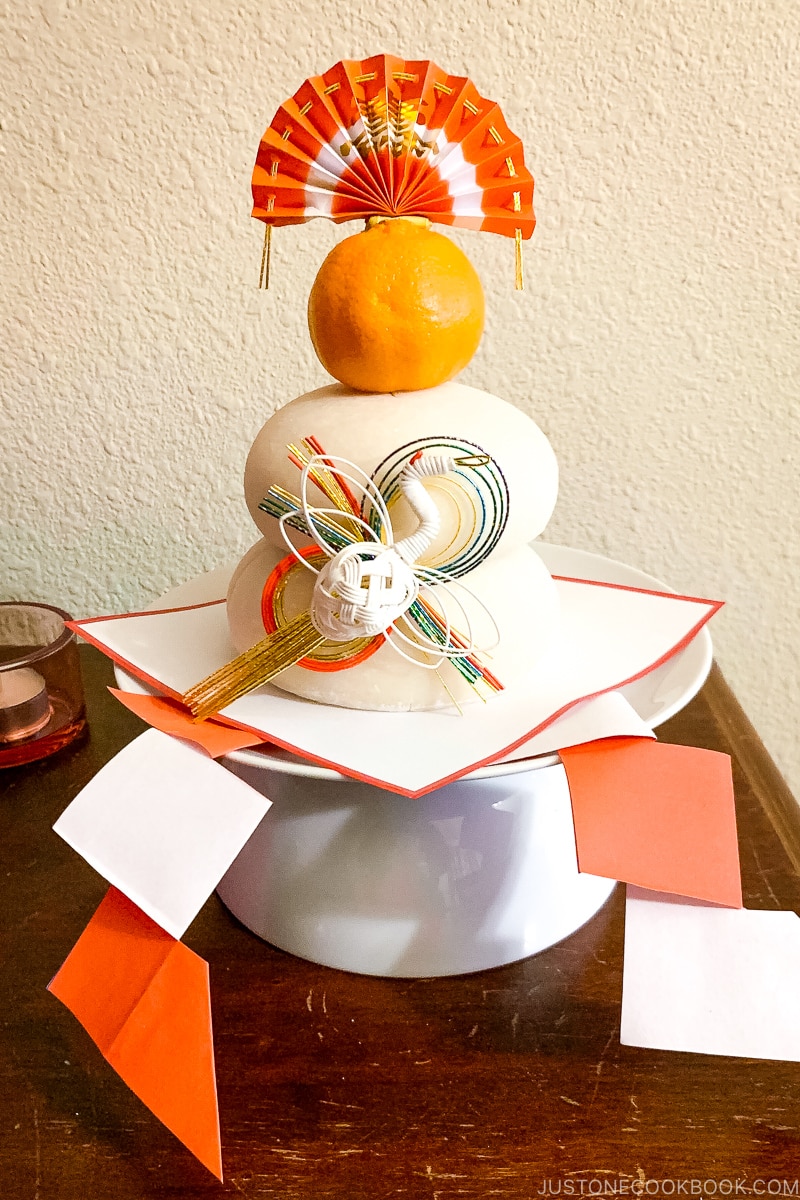
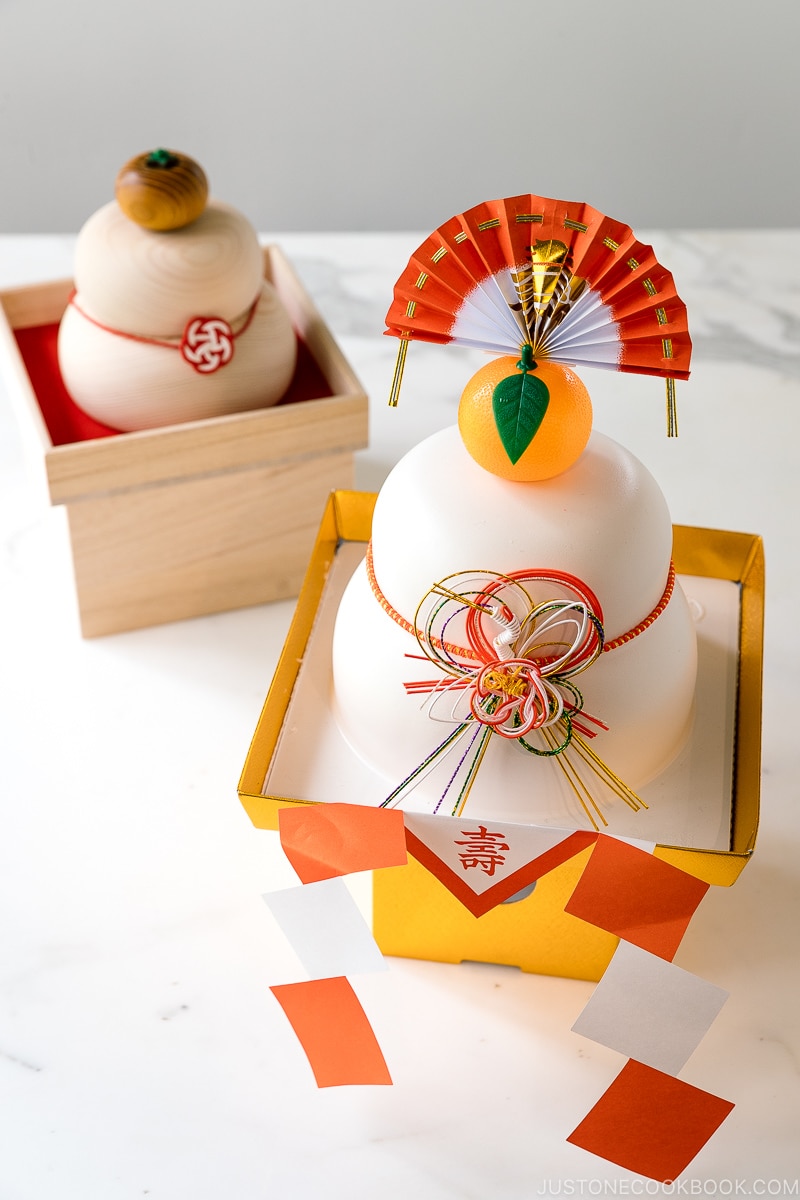
Kagami mochi is made of two round mochi, with the smaller mochi placed atop the larger one. The round shape of the mochi represents harmony in the family, and the mochi’s stretchy texture symbolizes hopes for longevity. A ‘daidai’ Japanese orange is then placed on top of the mochi, along with leaves and other decorations.
December 29th to 31st
When I was growing up, we usually spent New Year’s Day with my mother’s side of the family in Osaka. While the men in the family were assigned to deep clean the house, all three generations of women—my grandma, my aunts, my mom, and I—gathered in the kitchen all day long, typically starting on the 29th, to make the traditional Japanese New Year foods known as osechi ryori (おせち料理) or osechi (おせち) for short.
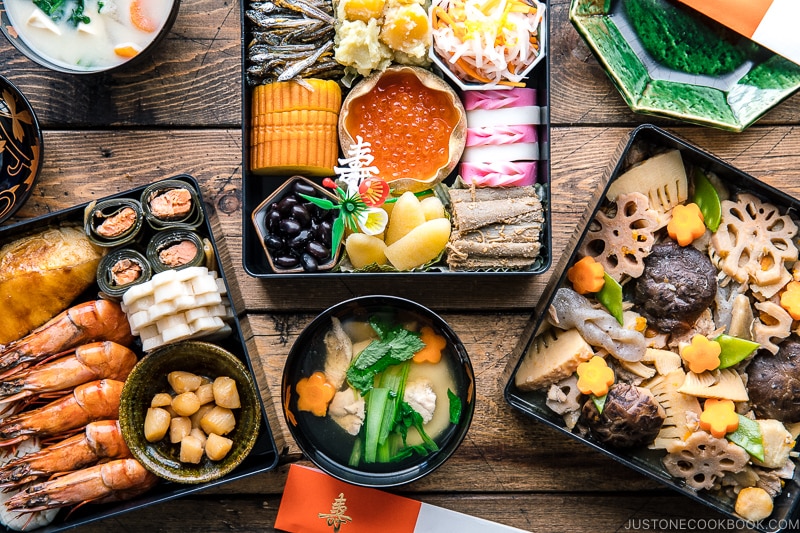
If you’re interested in making osechi ryori dishes, I’ve shared a delicious spread of recipes here. These symbolic foods, such as Kuromame, Kuri Kinton, Tazukuri, Namasu, and Datemaki, carry good meanings for the new year.
🍱 Get Japanese New Year Osechi recipes!
New Year’s Eve (Omisoka)
New Year’s Eve is called Omisoka (大晦日). The Japanese usually celebrate New Year’s Eve and New Year’s Day with family, as the holiday is equivalent to American Thanksgiving or Christmas.
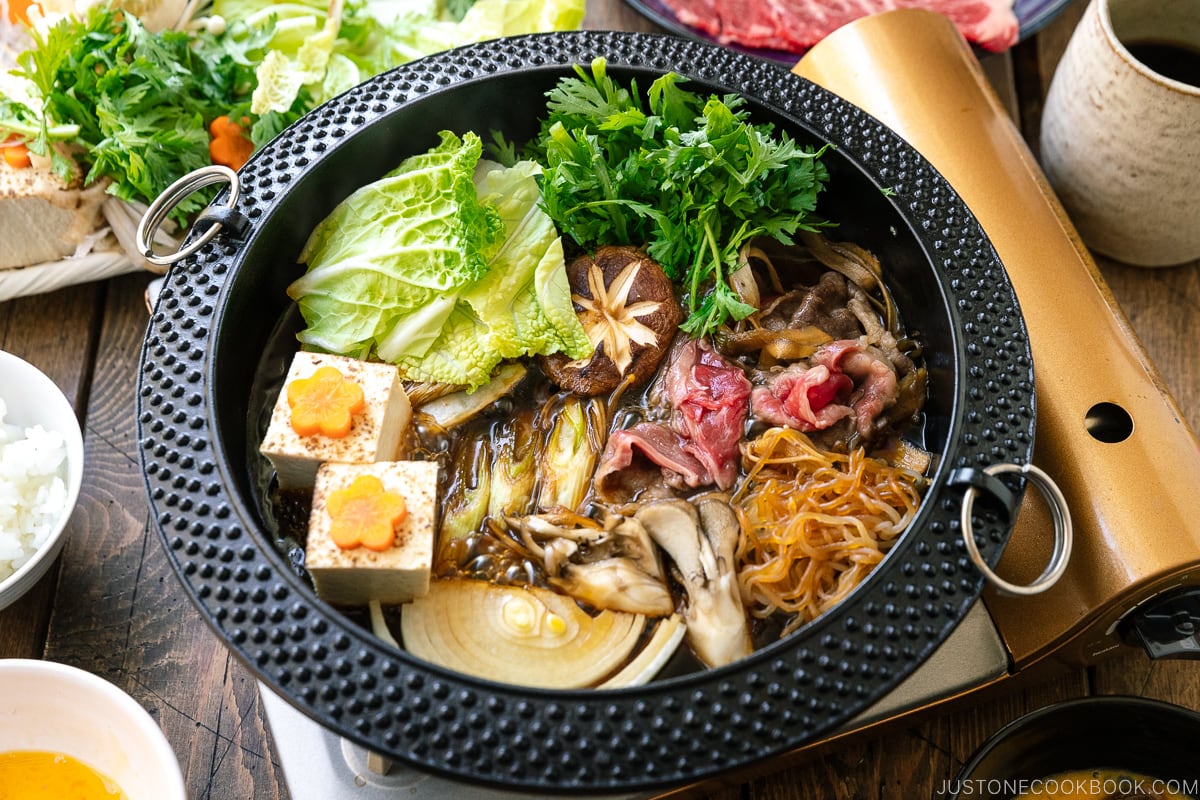
Each family has a different tradition for New Year’s Eve dinner, but the popular menus include Sushi, sashimi, and Hot Pot such as Sukiyaki (above), Yosenabe, and Shabu shabu (below). In some regions of Japan, people even start eating osechi ryori on New Year’s Eve.
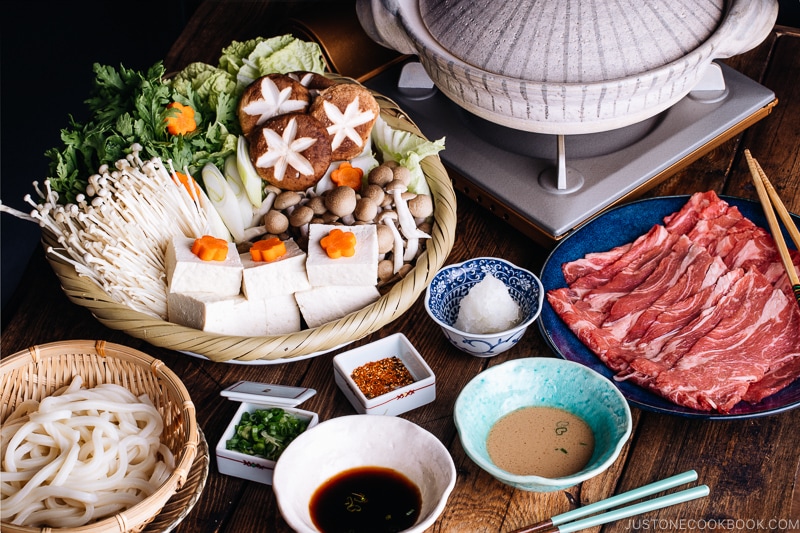
My family usually prepared Sukiyaki or Temaki Sushi (Hand Roll Sushi) as the last meal for the year.
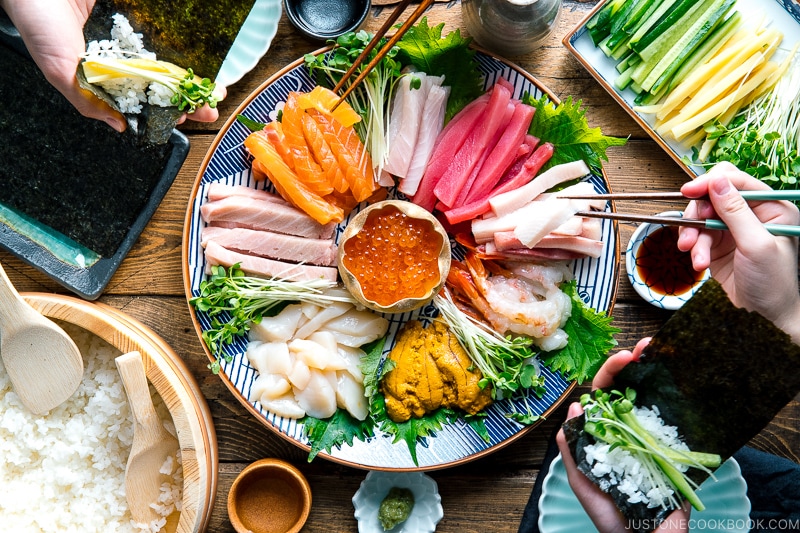
At night, many people enjoy watching a popular music contest broadcasted by NHK (Japan Broadcasting Corporation) called Kohaku Utagassen (紅白歌合戦). It is a singing contest between the red team (female singers) and the white team (male singers). The participants include young J-pop singers as well as Japanese ballad Enka singers, all performing live on stage. At the end of the show, the audience casts their votes for the red or white team.
Before the year ends, the Japanese must eat Toshikoshi Soba (年越し蕎麦). It is auspicious to eat buckwheat noodle soup because the long, thin noodles symbolize longevity. We used to eat a small bowl of soba as a snack while watching the singing contest.

As far as midnight traditions go, the Japanese stay up until midnight to listen to the 108 chimes of temple bells, which we call joya no kane (除夜の鐘). Just before midnight, temples throughout Japan strike their big bells 108 times.
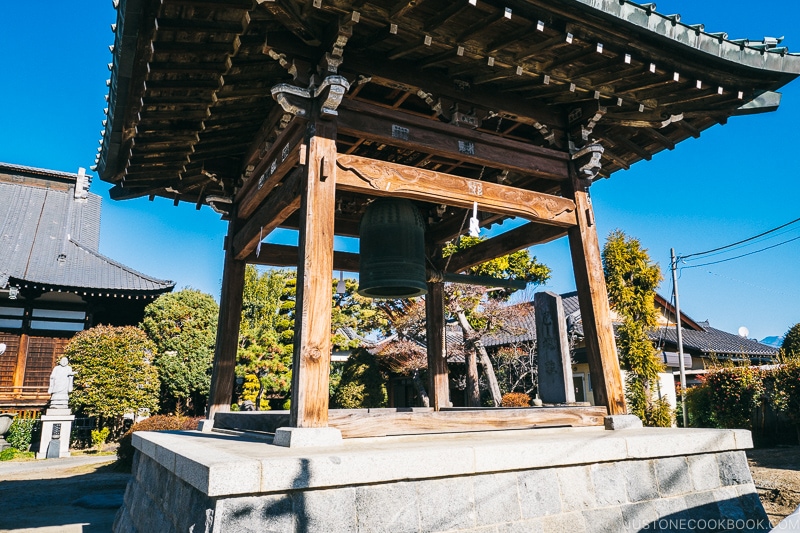
In Buddhism, ringing the bell 108 times is believed to help people get rid of their evil passions and desires, purifying their hearts for the upcoming year. The bell is rung 107 times on the 31st and once past midnight.
By the way, anytime before 11:59 PM on December 31st, the Japanese say, ‘Yoi otoshio!‘ (良いお年を), which means ‘Have a nice year!
After the New Year, you say, “Akemashite omedeto (gozaimasu)!“ (明けましておめでとうございます), which means “Congratulations on the New Year!”
New Year’s Day (Ganjitsu)
In Japan, the New Year’s celebration takes place on the first three days of the month. Most businesses shut down from January 1st to January 3rd, and families typically return to visit their hometowns and spend these few days together.
On Ganjitsu (元日), the first day of the New Year, many people strive to wake up early and go to a scenic spot to greet the first rising sun, hatsuhinode (初日の出).
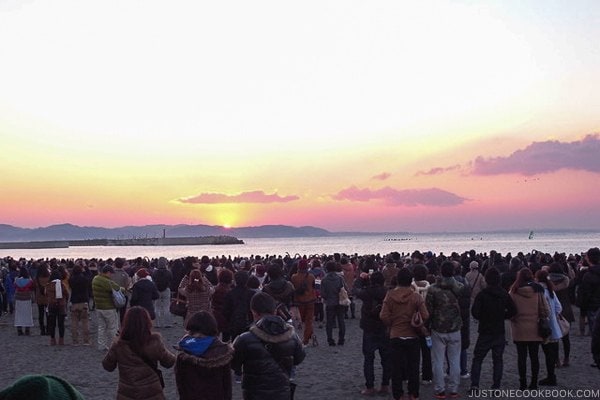
In the morning of January 1st, the family gets together to eat osechi ryori (おせち料理). The traditional foods are packed in two to three layers of jubako boxes (お重箱). What kinds of foods do we eat? Please read this post dedicated to osechi ryori.
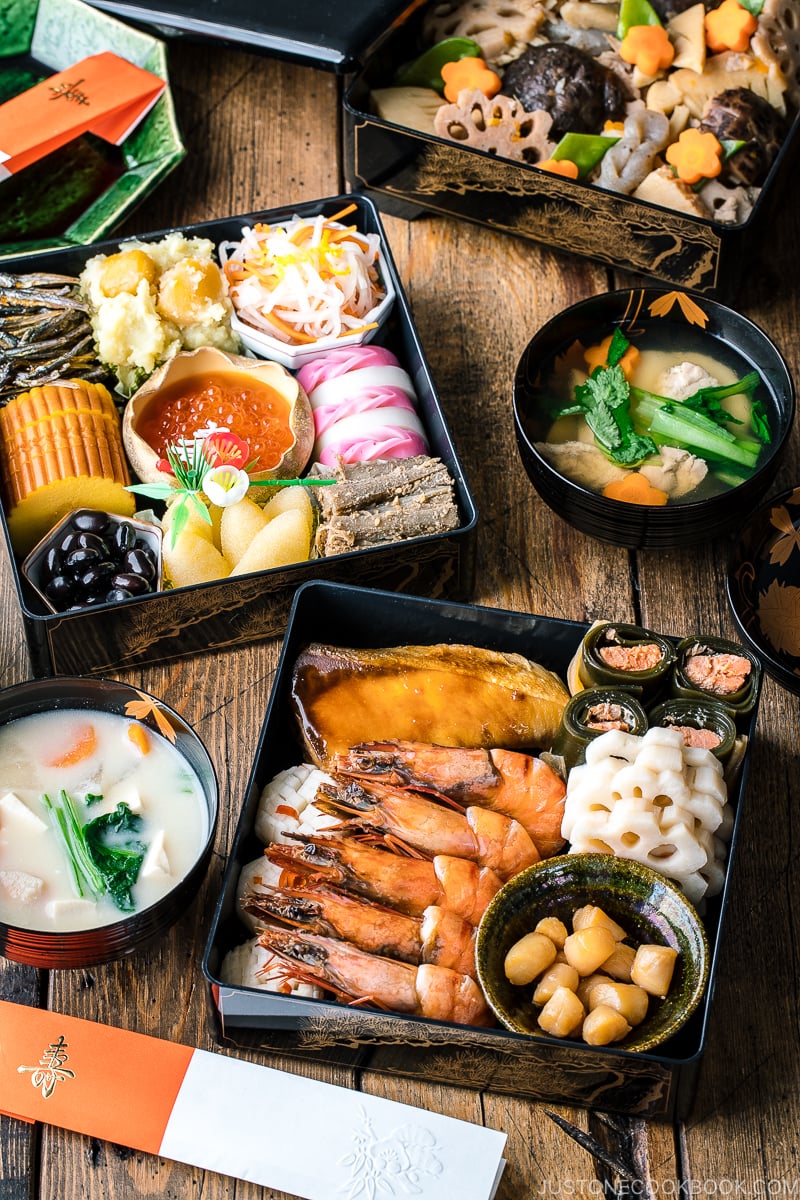
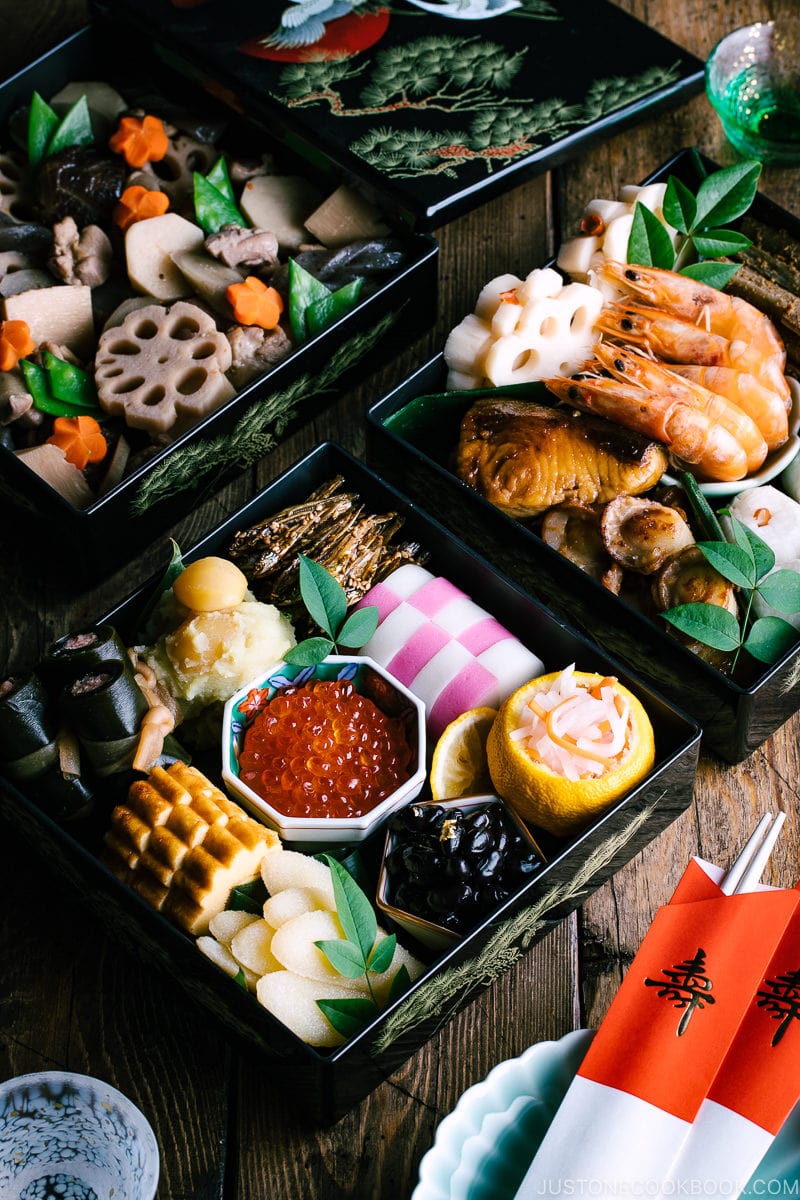
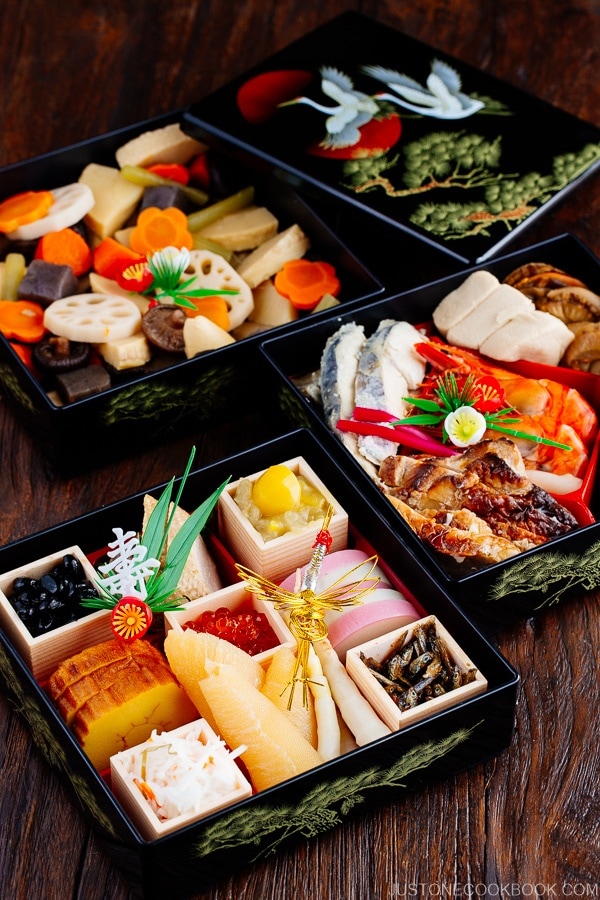
Along with osechi, the Japanese also eat mochi rice cakes and drink sweet medicinal sake otoso (お屠蘇) and a mochi soup called ozoni (お雑煮).
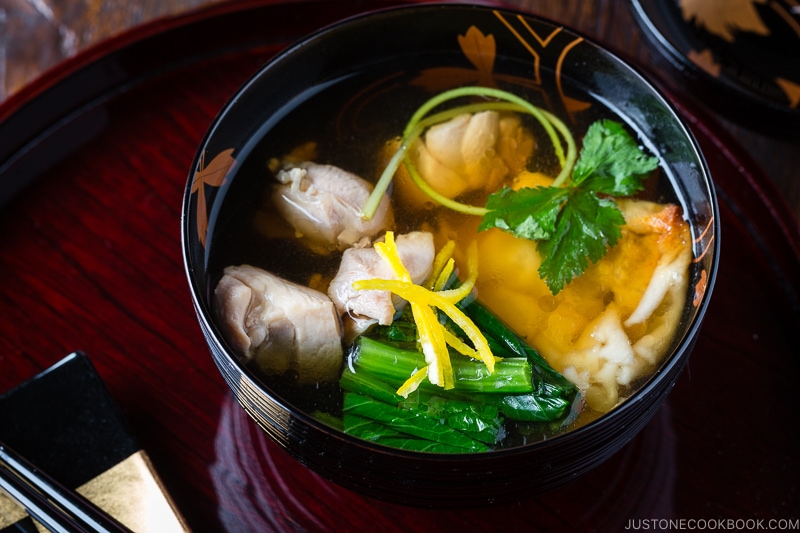
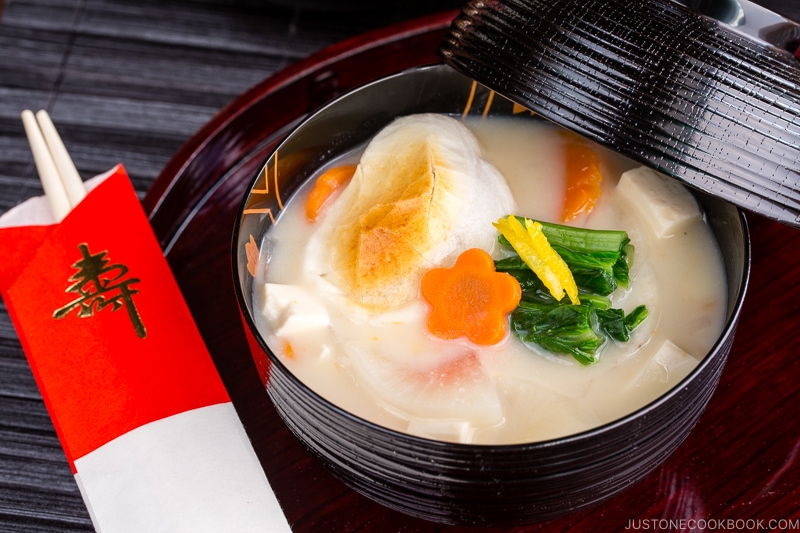
I have Kanto-style Ozoni and Kansai-style Ozoni recipes on my blog.
After the meal, the family gets together to read nengajo (年賀状), New Year’s greeting cards specially marked to be delivered on January 1st. Nengajo usually feature the Chinese zodiac sign of the New Year, as each year is represented by an animal.
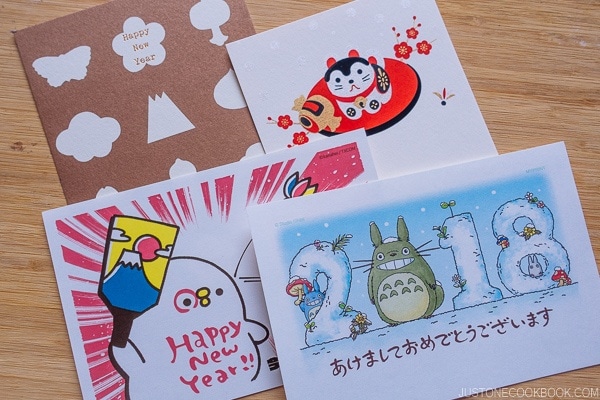
One of the exciting things for children on New Year’s Day is to receive otoshidama (お年玉), a money gift in a small envelope, from their parents, relatives, or acquaintances. I used to look forward to visiting my dad side’s big family get-together, where I received otoshidama from my uncles and some of my older cousins.
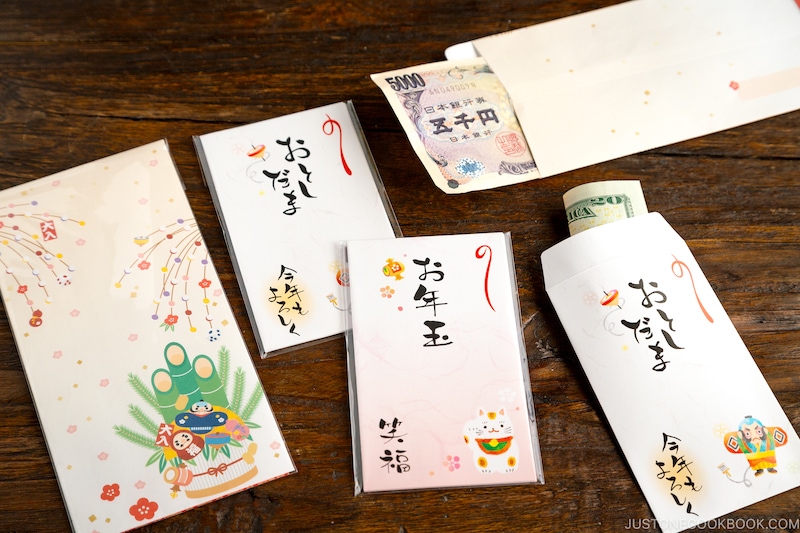
There are a few games that are traditionally played on the New Year. Some of my favorites include Japanese badminton with a wooden rectangular racket called hanetsuki (羽根つき), kite flying called takoage (凧揚げ), and a card game called karuta (かるた) shown above.
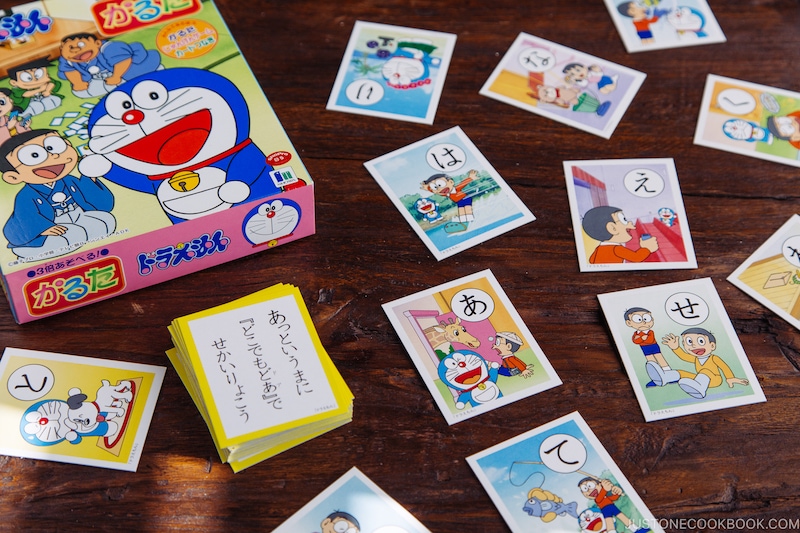
During the first three days of the New Year, the Japanese also visit a shrine or temple to pray for happiness and good luck in the coming year, and this visit is called hatsumōde (初詣).
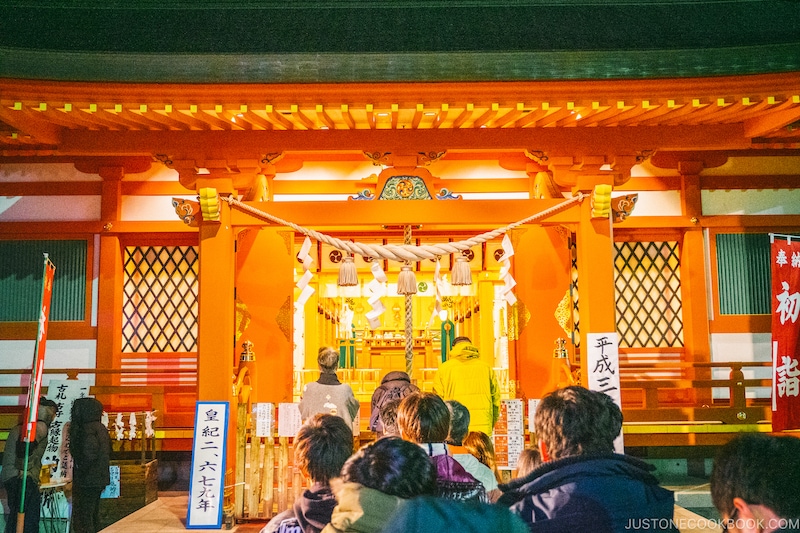
This tradition, deeply ingrained in Japanese culture for centuries, is observed by most places of worship. Popular shrines like Meiji Shrine (明治神宮) in Tokyo can easily attract several million people during the three days. Many women take this opportunity to dress up in colorful kimono (着物) for their visit. Visitors will also buy a good luck charm called omamori (お守り) at the temple, which is kept as protection from illness, accidents, and disasters.”
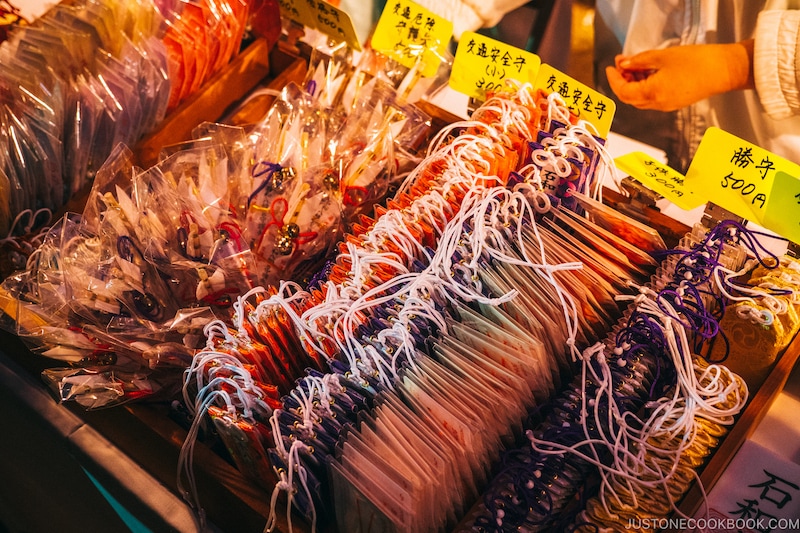
Once the New Year begins, we serve blush pink mochi confections called hanabira mochi (花びら餅). It is only available in January and is served at the first tea ceremony of the new year. The semicircular mochi has sweetened pieces of burdock root protruding from both sides and white miso in between.
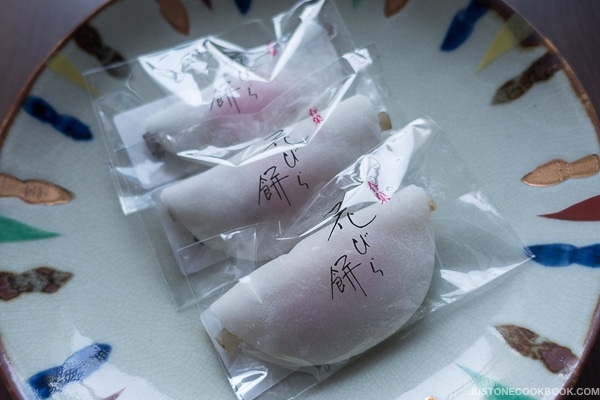
Said to be a simplification of hagatame no gishiki (歯固めの儀式), literally meaning “teeth hardening ceremony,” it dates back to the Heian period (794-1185). Hard foods such as wild boar, daikon, or salted sweetfish were sandwiched between red and white mochi, and eaten by the Imperial Court to wish for a healthy and long life (with good teeth!). Over time, it took on the form we see today, the sweetfish filling replaced by the burdock root.
The wagashi became known outside of Kyoto during the Meiji period (1868-1912), thanks to the Urasenke (裏千家) family, a highly prominent tea school. Compared to other wagashi varieties, hanabira mochi isn’t well known, and for those who do, is bought rather than made at home.
Now that you have learned how the Japanese celebrate New Year, I hope you have the opportunity to visit Japan and experience this special time of the year. I believe it will be a highlight of your stay.
As a Japanese living overseas, I wish that the spirit of the Japanese New Year celebration will continue to be passed on to the next generations. It is truly a time when we gather to appreciate the many customs that are steeped in history.
Happy New Year!
明けましておめでとうございます!
Akemashite omedeto gozaimasu!
More on the Japanese New Year Celebration
- Kagami Biraki “Open The Mirror” – Breaking Mochi Ceremony
- Celebrating New Year in Japan
- Osechi Ryori (Japanese New Year Food)
- Amazake (Japanese Fermented Rice Drink)
Editor’s Note: This post was originally published on December 29, 2015. The images and content have been updated in December 2017.

